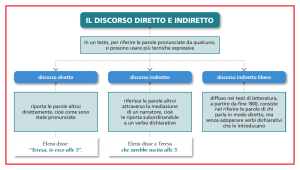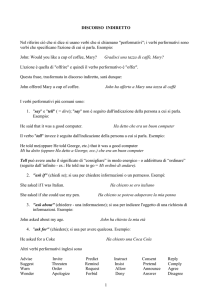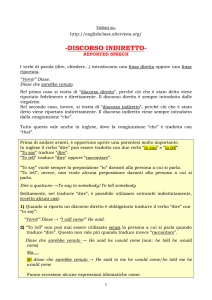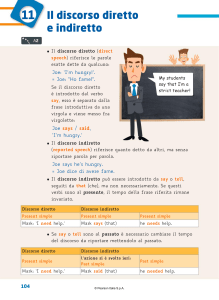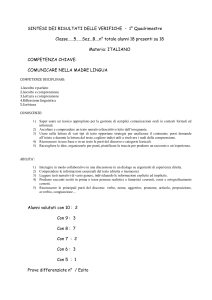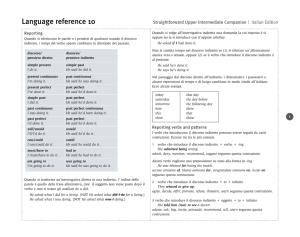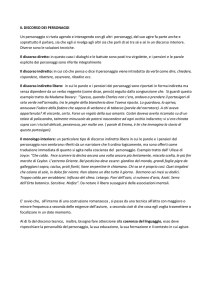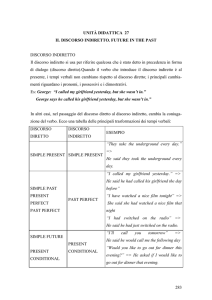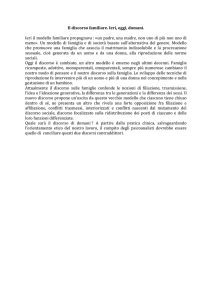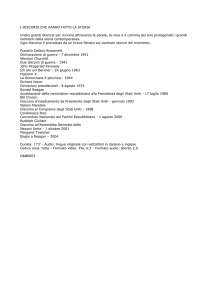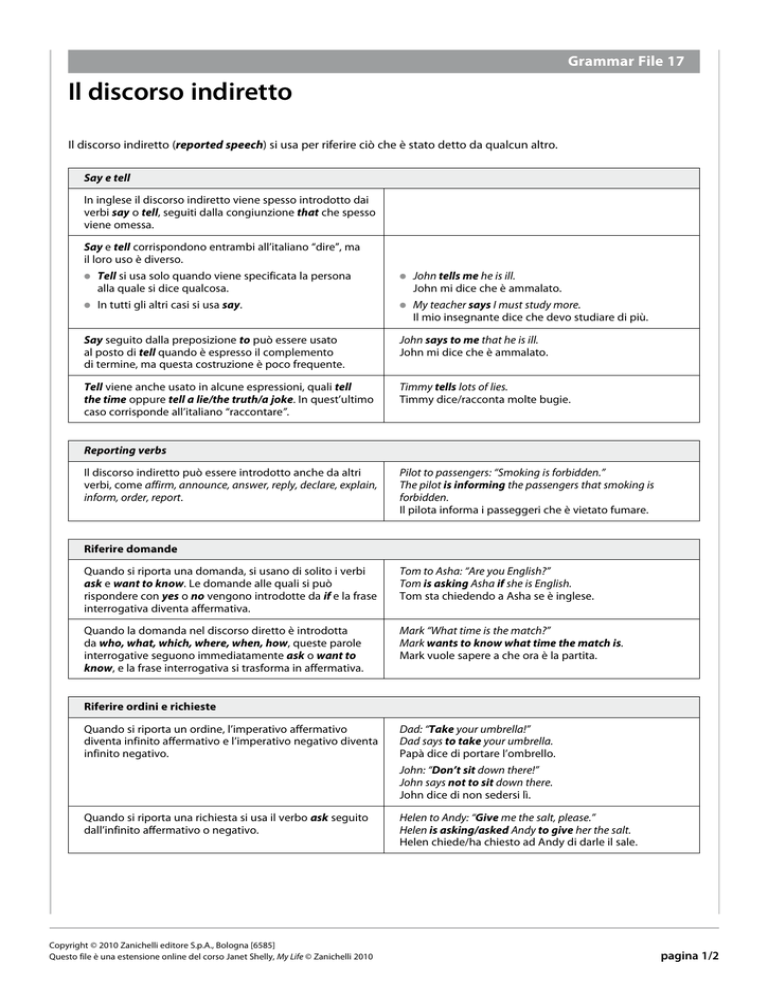
Grammar File 17
Il discorso indiretto
Il discorso indiretto (reported speech) si usa per riferire ciò che è stato detto da qualcun altro.
Say e tell
In inglese il discorso indiretto viene spesso introdotto dai
verbi say o tell, seguiti dalla congiunzione that che spesso
viene omessa.
Say e tell corrispondono entrambi all’italiano “dire”, ma
il loro uso è diverso.
⦁ Tell si usa solo quando viene specificata la persona
alla quale si dice qualcosa.
⦁ John tells me he is ill.
John mi dice che è ammalato.
⦁ In tutti gli altri casi si usa say.
⦁ My teacher says I must study more.
Il mio insegnante dice che devo studiare di più.
Say seguito dalla preposizione to può essere usato
al posto di tell quando è espresso il complemento
di termine, ma questa costruzione è poco frequente.
John says to me that he is ill.
John mi dice che è ammalato.
Tell viene anche usato in alcune espressioni, quali tell
the time oppure tell a lie/the truth/a joke. In quest’ultimo
caso corrisponde all’italiano “raccontare”.
Timmy tells lots of lies.
Timmy dice/racconta molte bugie.
Reporting verbs
Il discorso indiretto può essere introdotto anche da altri
verbi, come affirm, announce, answer, reply, declare, explain,
inform, order, report.
Pilot to passengers: “Smoking is forbidden.”
The pilot is informing the passengers that smoking is
forbidden.
Il pilota informa i passeggeri che è vietato fumare.
Riferire domande
Quando si riporta una domanda, si usano di solito i verbi
ask e want to know. Le domande alle quali si può
rispondere con yes o no vengono introdotte da if e la frase
interrogativa diventa affermativa.
Tom to Asha: “Are you English?”
Tom is asking Asha if she is English.
Tom sta chiedendo a Asha se è inglese.
Quando la domanda nel discorso diretto è introdotta
da who, what, which, where, when, how, queste parole
interrogative seguono immediatamente ask o want to
know, e la frase interrogativa si trasforma in affermativa.
Mark “What time is the match?”
Mark wants to know what time the match is.
Mark vuole sapere a che ora è la partita.
Riferire ordini e richieste
Quando si riporta un ordine, l’imperativo affermativo
diventa infinito affermativo e l’imperativo negativo diventa
infinito negativo.
Dad: “Take your umbrella!”
Dad says to take your umbrella.
Papà dice di portare l’ombrello.
John: “Don’t sit down there!”
John says not to sit down there.
John dice di non sedersi lì.
Quando si riporta una richiesta si usa il verbo ask seguito
dall’infinito affermativo o negativo.
Copyright © 2010 Zanichelli editore S.p.A., Bologna [6585]
Questo file è una estensione online del corso Janet Shelly, My Life © Zanichelli 2010
Helen to Andy: “Give me the salt, please.”
Helen is asking/asked Andy to give her the salt.
Helen chiede/ha chiesto ad Andy di darle il sale.
pagina 1/2
Grammar File 17
Nel passaggio dal discorso diretto al discorso indiretto, scompaiono le virgolette e si verificano dei cambiamenti in
alcune parti della frase.
Discorso diretto
→
Discorso indiretto
Esempi
Pronomi personali
I/you
we/you
→
→
he/she
they
Mira: “I’m tired.”
Mira says that she is tired.
Aggettivi e pronomi
possessivi
my/your
our/your
mine
→
→
→
his/her
their
his/hers
Alan: “I can’t find my books.”
Alan says that he can’t find his books.
Aggettivi e pronomi
dimostrativi
this
these
→
→
that
those
Mark: “These are good books.”
Mark says that those are good books.
Avverbi di luogo
here
→
there
Asha: “My driving teacher is here.”
Asha says that her driving teacher is there.
Avverbi di tempo
now
tomorrow
yesterday
→
→
→
then/at that time
the day after
the day before
Helen: “I came yesterday.”
Helen says that she came the day before.
Quando si riportano conversazioni avvenute nel passato, quindi con il verbo introduttivo al past simple, anche i tempi
verbali subiscono modifiche:
Discorso diretto
Discorso indiretto
present simple
past simple
Helen: “I have flu today.”
Helen said she had flu that day.
Attenzione: il tempo verbale rimane però al present
simple se ciò che viene riferito è ancora valido
nel presente.
Frances: “Brad is a teacher.”
Frances said that Brad is a teacher.
Mark: “My brother doesn’t like jazz.”
Mark said that his brother doesn’t like jazz.
present progressive
past progressive
John: “I’m talking to Mira now.”
John said that he was talking to Mira then.
past simple
past perfect
Dean: “I ordered a new car yesterday.”
Dean said that he had ordered a new car the day before.
present perfect
past perfect
Dean: “I’ve ordered a new car.”
Dean said that he had ordered a new car.
future simple
present conditional
Asha: “I will get my driving license.”
Asha said she would get her driving license.
Attenzione: in inglese, quando si riporta una frase
che nel discorso diretto viene espressa con il futuro,
si usa il condizionale presente (e non il condizionale
passato, come in italiano).
may
might
Mira: “Mum may be at home now.”
Mira said that her mum might be at home then.
can
could / was able to
Sam: “I can help you.”
Sam said he could help me.
have to
had to
Mira: “I have to go home now.”
Mira said she had to go home then.
Copyright © 2010 Zanichelli editore S.p.A., Bologna [6585]
Questo file è una estensione online del corso Janet Shelly, My Life © Zanichelli 2010
pagina 2/2

